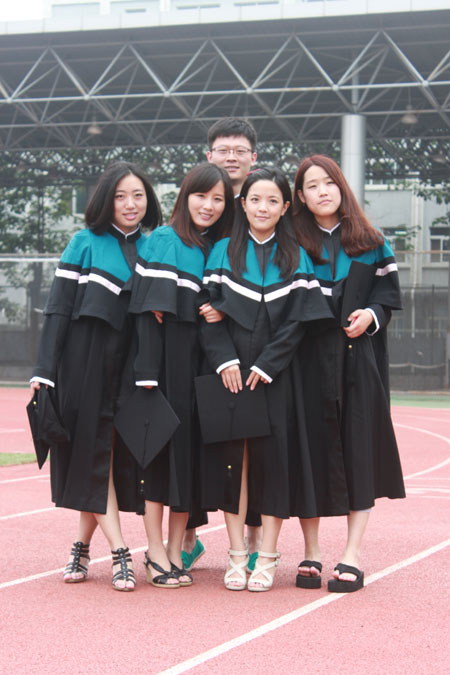Fresh graduates get a new look
Updated: 2012-06-30 08:00
By Gan Tian (China Daily)
|
|||||||||||
More than 1,400 graduates from the Beijing Institute of Fashion Technology were the first to wear a new design of graduation robes for their commencement ceremony this week.
The graduation gown, created by the institute's fresh graduate Li Jiapei, consists of a long robe and a cape. The gown has a special element - a standing collar - borrowed from Mao suits.
On the cape is a thick layer of light blue, and there are embroideries on the sleeves and collars. These patterns are inspired by BIFT's school badge.
The color stripes indicating the various academic fields are moved to the lower part of the cape. But no changes have been made to the cap.
|
The new graduation gowns are well received among students. Provided to China Daily |
In late April, the institute called for design submissions of a new graduation gown for its graduates. Three top graduates in the engineering department submitted drafts and students were invited to vote for their favorites. Li's designs stood out.
"It is BIFT's graduation ceremony, so I decided to use some patterns and colors representative of the institute. At the same time, I wanted to put some Chinese elements in the design. The commonly used graduation gowns are very westernized," Li explains.
Initially, the 22-year-old designer tried to use elements from traditional Han Chinese attire but gave up because it was too complicated. She later decided to add standing collars from Mao suits because they are "simple and elegant".
"When designing this graduation gown, I had to consider the international standards of bachelor's gowns. That's why I didn't change the basic style," Li says.
The basic rules include ensuring it is formal and elegant, keeping deep colors and having minimal decorations.
Universities can personalize their graduation gowns by adding their iconic color block on the cape or adding their school badge's patterns to the sleeves and collars, Li adds.
Although she spent only one week on the project, her creations won positive feedback on and off campus.
Cui Yuxi, one of the graduates this summer, says the new gown looks trendy and resemble the magic robes in Harry Potter movies.
Modern graduation gowns were introduced to China in the early 20th century. Many students who studied overseas like China's late architect and writer Lin Huiyin brought back the idea of graduation gowns.
Ma Jiucheng, late associate professor at BIFT, standardized the modern graduation gowns in the 1980s, using varied colors to indicate different degrees: black for bachelor's degrees, blue for master's degrees, and red and black for doctorates.
He also moved the triangular color cloth, used to indicate the different faculties, to the hood.
Wang Qi, deputy dean of BIFT's school of fashion art, says the institute is applying for a patent on the new design and hopes to popularize it among other China's universities.
Contact the writer at gantian@chinadaily.com.cn
Today's Top News
Rescuers race against time for quake victims
Telecom workers restore links
Coal mine blast kills 18 in Jilin
Intl scholarship puts China on the map
More bird flu patients discharged
Gold loses sheen, but still a safe bet
US 'turns blind eye to human rights'
Telecom workers restore links
Hot Topics
Lunar probe , China growth forecasts, Emission rules get tougher, China seen through 'colored lens', International board,
Editor's Picks

|

|

|

|

|

|






